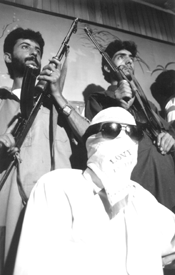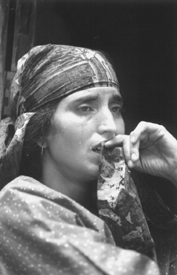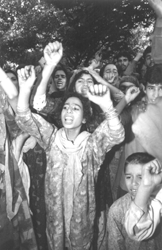

The killing of innocent Hindus by Pakistan-trained mercenaries in J and K is one more bid to convert the Kashmiriyat issue into a Hindu-Muslim problem
 |
I.A. Rehman, director of the independent Human Rights Commission of Pakistan (HRCP), also a core group member of the Pak�India People�s Forum for Peace and Democracy (PIPFPD), was among those shocked by the visit. �I am amazed by the visit of the minister�, he told Communalism Combat in a telephonic interview. �What did he want to say? What was the political intent behind the call? If the intention of the visit was to say that Pakistan supports the religious element, the communal element impinging on the Kashmir conflict, it must be unequivocally condemned because it will boomerang most strongly on the Kashmiri people.�
Rehman adds that any attempt to deepen the communalisation of the struggle in Kashmir which was a 75�year�old struggle of all Kashmiris � Hindus and Muslims, and others -- for political rights against a despotic Maharaja must be condemned. He recognises that it was the same communal elements who had forced the Kashmiri Pandits to get out of the valley in 1989�90. �If Kashmiri fighters begin to brandish the sword of this religion or that it is very wrong.�
Until this widely publicised visit of the Pakistan minister to the militant camp � which has been interpreted by a wide section of observers within Pakistan as in India and elsewhere, as open ideological support to the highly questionable activities of the Lashkar � Pakistan had limited itself to stating, in international fora that it is providing �political, moral and diplomatic support to the movement for freedom of the Kashmiri people.� Indian intelligence and other independent reports since 1989 have been pointing at the involvement of a section of the ISI in the insurgency in the Valley. The Pakistan government had stopped short, to date, of openly admitting monetary or arms support to the mercenaries acting in the name of Islam.
During his visit, Mushahid Hussain, it is reported by the Pakistani press, not only hailed the activities of the Markaz (centre for preaching) which trains and maintains the Lashkar�e�Taiba, but also said that the true concept of Islamic jehad (CC March 1998) was being promoted by the Markaz. This was reported by the Urdu daily, Khabren.
It was in the presence of Mushahid Hussain at the camp that the chief of the Markaz, Hafiz Mohammed Saeed spoke openly �about the liberation of Kashmir.� Very significantly, it was on the same night, April 17�18, that 29 persons were brutally massacred in Prankote village in Udhampur district in the upper reaches of the Jammu region �the focus of recent militant activity sponsored from across the border. Unlike in the case of the earlier massacre of Kashmiri Pandits at Wadhwana in the Valley on January 25�the killers have not yet been traced, nor the killings been �claimed� by any outfit � the Lashkar�e�Taiba has claimed �credit� for the butchery in Prankote.
 |
�What the Pakistan government is doing is utterly wrong and must be condemned,� said Rochi Ram, senior advocate from Sind, Pakistan and a prominent member of the HRCP told CC. �The movement in Kashmir is nationalist, not religious, not Islamist but for Kashmiriyat. Kya aap samajhti hain ki yeh hamari siyasat smajh sakti hai? (Do you think that the Pakistani establishment can understand that?). We may not have mainline parties that are openly Islamic or fundamentalist. But what about the propaganda allowed by the state from the mosques five times a day? �
More critically, the recent manoeuvres of the Pakistani state come close to sabre�rattling when seen in the context of a heightened militarist discourse on both sides of the border in recent months. The Prithvi vs. Ghauri Ghaznavi (the Pakistani President Tarar would like the next missile in the Pakistani stable to be named after Babar) missile�talk between New Delhi and Islamabad has swiftly replaced the hopes raised by the �Gujral doctrine� last year. This bodes ill for peace in south Asia. And, given the fact that with Nawaz Sharif in Islamabad and Vajpayee in New Delhi, both countries are headed by hard�line parties and leaders who have used the communal card to gain or retain power, the signs are even more ominous.
�What kind of peace are we talking about?� asked India�s former foreign secretary, J.N. Dixit, while speaking to CC. �Peace which is a compromise to the acquisitive, territorial interests of Pakistan? That�s not peace, that�s appeasement. Or peace with honour?�
For half a century, both Islamabad and New Delhi have unashamedly used Jammu and Kashmir and its people for their narrow political gains. The state of Jammu and Kashmir has been treated by both the Indian and Pakistani states as the �unfinished task� of Partition.
Despite the terms of the accession agreement, the Hindu Maharaja of a Muslim�dominated princely state agreed to cast its lot with secular India. Maharaja Hari Singh himself was against this accession, had to give in to the feelings of his people who were vary of a Pakistan that was uncomfortable with a distinct Kashmiri identity.
Mohamad Ali Jinnah, uncomfortable with the individualist and distinct ethno�cultural nationalist Quit Kashmir movement from the valley had dubbed it �a movement of goondas�. Leave apart full autonomy and plebiscite, assured to the J and K under the instrument of accession, New Delhi has never even trusted and granted to the state and its local leadership with even basic democratic rights. Since 1989, this basic lack of trust has several times been compounded with state-sponsored brutality of the civilian population reaching condemnible proportions (see accompanying story).
�The recent visit of the Pakistan minister to the militant camp is only a confirmation of what they have been advocating more covertly,� Dixit added. In my mind, this also signifies a stepping up of manifest support to the separatist movement. This will lead to even further resistance by the Kashmiri people, in particular, and India, in general, to the designs of Pakistan.�
The Pakistani state�s interest in Kashmir dates back to independence and Partition. The decision of the people of Jammu and Kashmir to accede to secular India defied the foundations of the Pakistan state based on a two�nation theory. Therefore, Pakistan has gone about its business in the region, sponsoring insurgency and violence. But what is far, far more questionable, is the attempt to impose a regimental Wahabi version of Islam on a Valley renowned for its Rishism (Sufism). Schools and madrasas run by the local Jamaat-e-Islami were rigorously used to attempt to transform the unique struggle for Kashmiriyat to visions of life under a Nizam-e-Mustafa (The Order of the Prophet).
The success of �Allah�s army� has been severely limited by the culture and ethos of the region that has defied regimentation into the conventional �Muslim� and �Hindu� bracket. Even today, reactions of ordinary Kashmiris, Hindus and Muslims alike, defies this labelling. Reports of grieving Kashmiri Muslims over the massacres is the most potent proof of this.
 |
�Across the board, all persons have condemned the Wandhama and Prankote massacres,� said Yasin Mallick while speaking to CC. Formerly a general of the Jammu and Kashmir Liberation Front( JKLF), he is today is one of the members of the All�Party Hurriyat Conference. �We have demanded that an international agency like Amnesty International be allowed to examine who was responsible for the killings. In our mind, it suits the Indian state as well to communalise the issue. Why was Amnesty refused permission? Why is the Indian government afraid of the truth getting out?�
Rajya Sabha MP and a staunch defendant of the people�s rights, Kuldip Nayar, who has been associated over the years with the region has just returned to New Delhi after visiting Reasi and Wandhama.
�At the local level there is shock, anger and despair in the Muslim survivors. They were the ones who performed the last rites of the victims of Wandhama,� he told CC. �My impression is that militancy has been more or less defeated. Therefore, the ISI�sponsored part of the movement knows it cannot succeed unless it divides the movement communally.�
The gutting of the 600-year-old shrine of Charar-e-Sharief on the road to Yusmarg in the Valley in May 1995 was mourned deeply by the people of the valley. Who was responsible? Pan�Islamic militants callous to the culture of the Valley or the Indian state, equally indifferent to the Valley�s proud and distinctive Kashmiriyat ? Folklore in the Valley even after the loss of Charar�e�Sharif revolves around the stories and songs about the close relationship between Sheikh Noor Adam and a Shaivite woman, Rishi Laleshwari. Is it insignificant that another 14th century shrine, Khanqah at Tral, a small town 39 km south of Srinagar and one more living symbol of the composite, Sufi tradition of the Valley was destroyed by another mysterious fire on December 18, 1997?
Schools and madrasas run by the local Jamaat-e-Islami were rigorously used to attempt to transform the unique struggle for Kashmiriyat to visions of life under a Nizam-e-Mustafa |
In the midst of state callousness and connivance and militant bestiality, the real ray of hope, for Nayar, is that despite sustained provocation and brutalisation, the people have not allowed themselves to get divided. �No force has yet been able to distort the basic culture of Sufi Islam. I have still the soundest hope that the basic culture of Kashmir will assert itself.�
Admiral Ramdas, former chief of the Indian navy who is today vice president of the India chapter of the PIPFPD, agrees that the movement has got communalised but blames the Indian state for failing to address the political dimensions of the issue. �Communalisation, whether overt or covert is reprehensible and needs to be condemned. The reasons for the brutalisation of the state of Kashmir is not due to the presence of the troops, as much as due to the callous neglect by the Centre which has succeeded in creating a situation warranting deployment of troops,� admiral Ramdas told CC. �This situation has been fully exploited by the Pakistani government and its extended arm, the ISI.�
Nayar, who has recently donated the entire Rs. 1 crore available to his as a MP to widows and orphans of violence in Srinagar, strongly argues for a quick political end to the issue through a three�party negotiated settlement. He also points out that the Indian government, by its intransigent and problematic stances now and in the past, has also contributed to the communalisation of the movement.
An example is the pre�election rhetoric of the NC and the Centre of �return of Pandits to the valley connected to �normalcy� returning�. �Why should we connect the two?� he asks. The Kashmiri wants his rights, not �normalcy� but he also wants his sisters and brothers, the Kashmir Pandits, back. By linking the two, we are asking for too much: for the Kashmiri to give up his legitimate struggle for genuine autonomy!�
Nayar strongly feels that the government of India must honour its commitment under section 370 of the Constitution and go back to the state assembly with all the legislation extended by the Centre to the state, with all the laws implemented after 1952��53 and leave it to them to decide which they want to keep or abrogate. �Personally, the issue of plebiscite I feel is a far gone one now, 50 years too old and one apt to be converted to a religious pin�pong between two sides. No one can really afford it.�
Teesta Setalvad